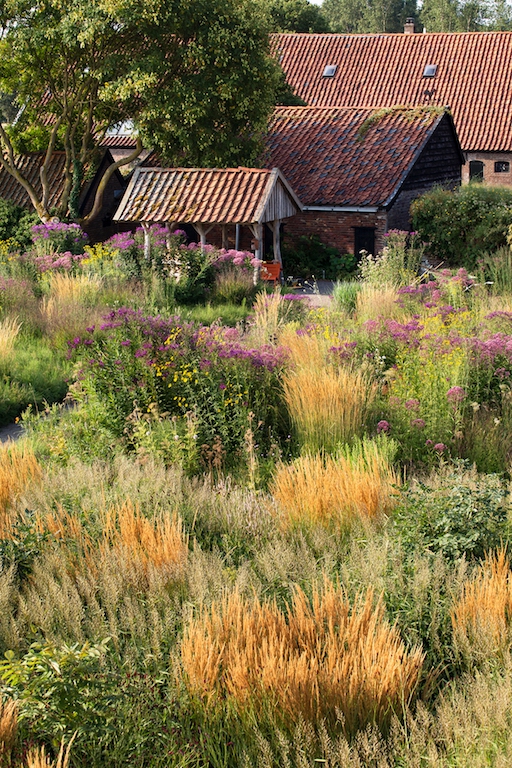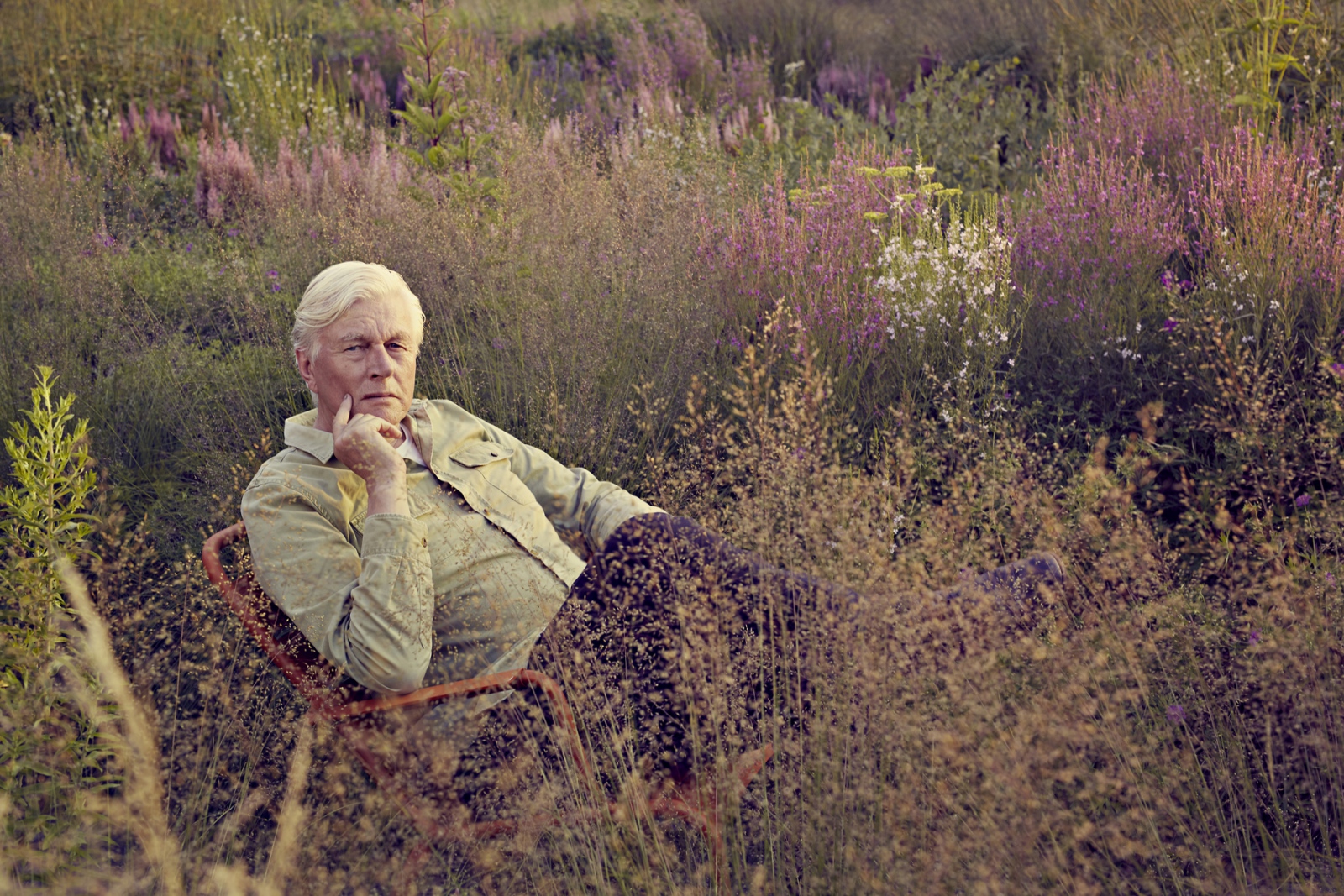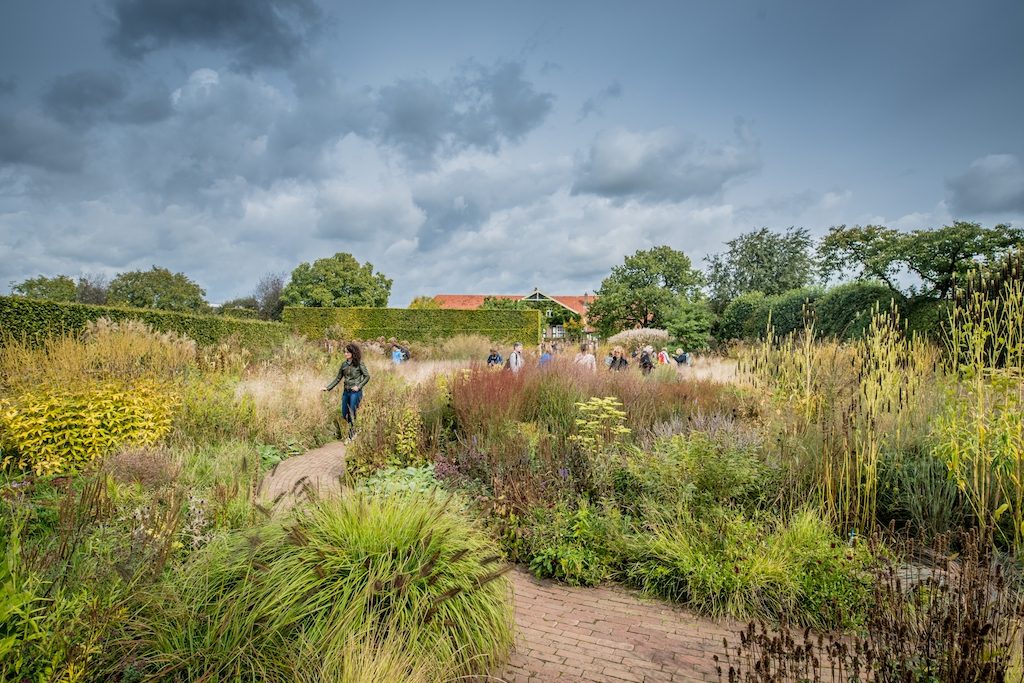After nearly 40 years of welcoming the world through its gates, the private garden of Piet and Anja Oudolf at Hummelo will close to the public for good at the end of this month.
For all lovers of this most quintessential garden that galvanized an entire movement in naturalistic planting design, the news cuts deep.
Word of its closing has spread like wildfire-weed amongst garden folk and it’s inspired a kind of spontaneous pilgrimage of people visiting Kwekerij Oudolf one last time.
On a recent weekend, buses were lined up outside Broekstraat 17 with over 100 cars parked along the country road.
Social media is swarming with heartfelt posts and photos from people taking their final strolls through the garden.
There’s an even larger flood of likes, loves, and comments from envious folks like myself who can’t be there in person.
Marking the moment
This is garden history in the making.
So, I’ve asked a few Dutch Dreamer photographer and designer friends to help mark the moment as I post this unofficial tribute to Hummelo through words, and photos, many of which were just taken in the past few weeks (hover to view credits.) There’s even a video created just for the occasion.
Sure, we can mourn the end of something truly great. But in true New Perennial style, let’s celebrate it too.
This includes you. Scroll down to the comments below the story and tell us what Hummelo means to you.


Cutting the knot
The decision to close to the public is perfectly understandable. While Anja has adroitly handled the flow of visitors (increasingly by the busload) just as she ran the Oudolf nursery for decades, Piet’s highly active public design work has become the priority.
After all these years of opening the garden to a curious world, Anja recognizes the reality that, “At a certain moment you have to cut the knot.”
Surely, they deserve their freedom.
For those of us fortunate enough to visit Hummelo over the years, the experience was often revelatory and near impossible to put into words.
I visited the garden twice in the past decade – at different points in the season – and each time the experience proved to be life-changing.
On a purely visual level, the fascination is endless in a garden where the paths circle into each other presenting a constantly shifting perspective of the myriad plantings.
As Piet reminds us, “It goes deeper than what you see”. There’s the feeling of reconnecting with the numinous mysteries of life itself. When plants are ascendant, we glimpse something beyond our merely human selves.
At Hummelo, it distinctly feels like the plants are watching you.



A love story
Whoever imagined back in the early 1980s that a dilapidated country farmhouse on a few acres in the eastern Netherlands near the small village of Hummelo would emerge to become a paragon of innovation in modern planting design?
It represents the life’s work of two indomitable creative spirits, Piet and Anja Oudolf who together renovated the house, raised a family, created epochal gardens, established a plant nursery, published books, and built a solo design practice from which Piet could export his vision to the world.




A living laboratory
The extensive Hummelo nursery was an integral piece of the puzzle. It served as a living laboratory for 28 years where Piet and Anja collected, propagated, trialed and refined what became his signature palette of robust perennials and grasses necessary for his designs.
The Oudolf plant catalogues were legendary as the nursery built a keen following with a reputation for wilder looking species and out of the box thinking.


You can view many of the seminal plants from the Hummelo nursery in the online image archive set up by American designer, Adam Woodruff.



After closing in 2010, Piet boldly transformed the former nursery space into a wild meadow experiment, combining structural perennials left over from the nursery stock with a matrix of native grasses and forbs grown from seed.
It’s a natural continuum of his design approach as he explores the line between control and freedom.
The Roots of Hummelo
Hummelo has always been a nursery of ideas where people and plants have crossed paths in unexpected and radical ways.
In the early 1980s, Piet and Anja hosted a series of Garden Days that became the genesis for a movement dubbed The Dutch Wave. The words of their philosopher friend, the late Rob Leopold, take us back to that time:
After a hesitant start in the mid-eighties, open weekends for the public at Piet Oudolf’s nursery in Hummelo quickly became something of a national event in Holland. These few days once a year when the keen amateur gardener could meet the professionals soon turned into a little Chelsea.
In the third weekend of August, young nursery-men, new style garden designers, progressive publishers, professional journals and a variety of garden foundations met with an enthusiastic and committed public, exchanging whatever they had to offer. Though aware of its small scale, Hummelo was a lively focus of the new movement during these few days of the year.
Plants and experience were exchanged, new contacts were made, projects were set in motion. Publishers and authors officially presented their latest books. One returned home afterwards full of impressions, new inspiration and the very latest ideas.
The collectively creative spirit was the progressive driving force behind the new movement. Nurserymen, garden pioneers, certain writers and photographers and a young publishing house formed, right from an early stage, a solid and enthusiastic group.
Nature and Garden Art, 1994
The last Garden Days in Hummelo were held in the summer of 1991 after which, it morphed into a fall event called Grassendaggen.


Another friend, Henk Gerritsen was an iconoclast with vast botanical knowledge who helped Piet to envision a starkly different idea of beauty in the garden – one which recognized the role all forms of life and death can play.
In his masterwork, Essay on Gardening, Henk captures the essence of the Dutch Wave as a movement with no agenda:
It was never a movement in the usual sense of the word, which has clearly defined objectives. Everyone was (and is) too individualistic for that. It was rather a counter-movement, the most important elements of which were, in the words of Rob Leopold: natural diversity, individual values of perception and artistic development’. In other words, a ‘movement’ therefore that puts an end to all previous movements and their strictly prescribed rules.
To go deeper into the history, Piet’s biography, Oudolf Hummelo: A Journey Through a Plantsman’s Life written by frequent collaborator Nöel Kingsbury is the definitive point of departure.

A higher frequency
It’s awe-inspiring to think how Hummelo has evolved from those early days. Everyone will have their own take on what makes it so extraordinary.
The garden itself will continue to grow away from public view, except of course, we can always keep in touch via Piet’s presence on Instagram.
 We can also summon a place like Hummelo through poetry to find ourselves once again in a garden we will never forget:
We can also summon a place like Hummelo through poetry to find ourselves once again in a garden we will never forget:
A garden is more than meets the eye
growth from the past
growth still to come
strolling through a garden
is like wandering through a vast memory
everything has an origin
faraway places always remembered
bonds with friends
some dead but immortal here
growth rings
you are the garden
Translated from Dick Hellenius, Collected Poems

Closing Time
Ah. Reality sets in. Only a few short weeks left till the final day on October 27th. If you can go, go!
How can we ever possibly thank Piet and Anja for making Hummelo what it has become?
One way is to share what it means to you. “Sharing is multiplying” as I once heard Piet say at Hummelo, talking about both plants and ideas.
All stories welcome. Goodbye, adieu, vaarwel.
A Royal Salute
On the final Saturday on October 27th, the Dutch King Willem-Alexander recognized Piet Oudolf as Officer in the order of Orange Nassau, a chivalric order open to individuals who have earned special merits for society.
What a fairytale ending to a remarkable year.
==
Special thanks to the following Dutch Dreamers and contributors who graciously provided images for this post: Hans van Horssen, Adam Woodruff, Piet Oudolf, Guy Henderieckx, Edwin Barindrecht, Laura Ekasetya, Marcel Silkens, Tony Spencer, and Charlie Hopkinson, Jan Ruland van den Brink, Bart Heynen, Louis-Philippe Beauduin. Check individual photo captions for credits.

Thank you for this lovely farewell, Tony.
I was fortunate to visit Hummelo way back in April 1999. I had heard Piet speak in Toronto (the year before I think) at what was then the Civic Garden Centre – now the Toronto Botanical Garden – and I was eager to see his garden. Piet was kind enough to sit down with me and spend time answering my questions about design and meadows. He and Anja still had the nursery then and she was working hard keeping that side of things going. For me, a meadow-lover, his approach was more intricate and interesting than the then-popular Oehme van Sweden New American landscape approach, which deployed perennials in vast blocks of colour. Piet’s meadows felt like nature had been in on the design process.
I wrote about this visit (with some photos from then) at the beginning of a 2-part blog I did on the creation of Piet’s Entry Border at the Toronto Botanical Garden. If you want to read it, you can find it here:
http://www.thepaintboxgarden.com/piet-oudolf-meadow-maker-part-one/
Beyond Hummelo and the Toronto Botanical Garden, I’ve visited (and blogged about) the wondrous High Line several times, his Seasonal Border at New York Botanical Garden, and the gardens at Battery Park. This August, I finally got to see Chicago’s Lurie Garden at a time when all the prairie species were offering a stunning contrast to the magnificent skyline of the city.
I won’t likely see Hummelo again, but I’m so happy to have had the chance to visit when I did.
You’re so welcome. I didn’t realize Piet spoke in Toronto that early on… interesting. You saw Hummelo a few years before Piet ripped it all up to create the matrix meadow, which in turn begat the High Line. Great to see you’ve visited and written about such a range of his public gardens.
Hi Tony,
An emotional piece of writing.
It feels as if we leave planet earth. But no! We and the garden will be there always for friends.
Piet
p.s. Was the nursery 6000 sq.meters? The total of our gardens and house is 1.3 hectares.
Hi Piet,
Well, both bits of news will come as a relief for garden friends;-) But yes, there’s a wave of emotion attached to all this. And I’m pretty sure this wave is also Dutch in origin!
Best,
Tony
p.s. Ah, let me fix the numbers.
Though I will never see Hummelo, it is a comfort that I have visited the Lurie Garden many times and the HighLine at least once. I have take hundreds of photos at the Lurie, and looking back at them is a pleasant winter evening pursuit. The Lurie Garden is firmly in my top ten of American gardens I have visited both public and private, and I have visited many. If my personal garden was Hummelo, I can completely understand the desire for solitude and privacy after so many years of sharing.
Beautiful essay, as usual Tony.
Much thanks, Jim. Inspired to rise to the occasion. Loved wrangling the photographers to make the visuals and the post into a group effort.
What a beautiful review of this amazing garden i visited twice over the past 10 years.
‘They deserve their freedom’ is exactly what we all deserve: we deserve to live the life we really desire following our hearts. Piet and Anja are for me examples of living the life at the fullest, thinking big. For me they are a great inspiration for my garden design. I will always be grateful for what they taught me in their books, in their garden, their life and their work. Thank you!
Sofie from Tuinen in Beweging
This is the most poignant and beautiful story that I’ve read in a long time. Thank you for the insight into a couple who certainly changed our “sights.”
Most gratifying. Thanks for your kind words.
i am a great admirer and visited the garden in Hummelo a lot of times.
see my website https://inekejanssentuinen.wordpress.com/oudolf
Hartelijke groeten aan Piet en Anja Oudolf
I was lucky to visit Hummelo last August with a group of Finnish garden enthusiastics. What a life changing experience for me and hopefully for others, too!
In person, I’ve only seen the echoes of Hummelo in gardens like the Toronto Botanical Garden’s entry garden, like Janet the Lurie Garden last summer, and an all-too-brief peek at the High Line. Lovely images and writing, Tony.
Hummelo is the mothership, which spawned all the other projects into being. The feeling, the atmosphere of the garden is supernal – like nothing else I’ve experienced. This post is a labour of love, for sure and I think it probably shows. I hope you’re able to get over to Europe at some point to experience some of these places for yourself.
Sehr geehrter Mr. Spencer,
Ich möchte Sie um die Genehmigung bitten, Auszüge aus Ihrem Blog sowie Fotos in meinem neuesten Buchrojekt verwenden zu dürfen, natürlich unter Angabe aller Urheber.
Mein Buch hat den Titel: “Der metaphysische Garten” und unter dem Kapitel “Vergessene, verschwundene, verlorene Gärten” möchte ich gerne Hummelo erwähnen.
Ich bedanke mich im Voraus für Ihre freundliche Genehmigung.
Mit den besten Grüßen
Christina R. Hirschochs-Villanueva, Autorin
http://www.coqui-verlag.de